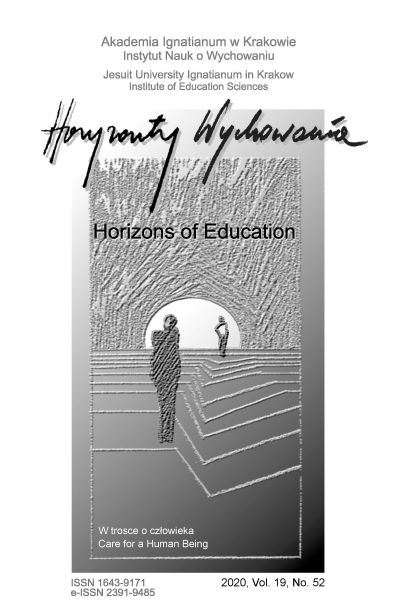What is the Impact of Multimodality and Intersubjectivity on the English Humour?
Abstract
RESEARCH OBJECTIVE: The purpose of my article is to demonstrate how the terms of multimodality and intersubjectivity function within the areana of English humour, specifically in reference to a chosen sitcom. To this means I shall employ the cognitive apparatus of conceptual integration theory, aka blending.
THE RESEARCH PROBLEM AND METHODS: The presented research problem centres around the notions of intersubjectivity, i.e. the human ability to display a shared perception of reality with regard to members of their own community, as well as multimodality, i.e. the use of more than one sense for the purpose of meaning rendition. Both phenomena are studied here with regard to the English humour, whose explanation is based on a cognitive linguistic method of blending.
THE PROCESS OF ARGUMENTATION: Having explained the term ‘English humour’, I then clarify intersubjectivity, multimodality and cognitive integration, which will serve here as the tools for the purpose of my humour analysis. Therein I intend to show how they interlink and how their roles influence the comprehension of English humour.
RESEARCH RESULTS: The result of this argumentation is constituted by the fact that intersubjectivity and multimodality together with blending can greatly enhance the comprehension of the amusing contents within English comedy.
CONCLUSIONS, INNOVATIONS, AND RECOMMENDATIONS: The analysis confirms that conceptual integration theory, as enriched by intersubjectivity and multimodality, provides a humour researcher with a concrete apparatus for measuring humour effects. However, further research is advocated into the process of blending, as accompanied by intersubjectivity and multimodality, with recourse to English humour as well as other types of humour, e.g. the Polish comedy, in order to provide contrastive evidence for these tools and their usefulness or effectiveness.
References
Atkins, K. (2005). Self and Subjectivity. Oxford, UK: Blackwell Publishing.
Lieselotte, B., Ghesquiere, L., & Van de Velde, F. (Eds.). 2014. Intersubjectivity and Intersubjectification in Grammar ad Discourse. Theoretical and descriptive advances. Amsterdam, the Netherlands: John Benjamins Publishing Company.
Blackwell Encyclopedia of Sociology. Retrieved 2 March 2019 from: http://www.blackwellreference.com/public/tocnode?id=g9781405124331_chunk_g978140512433115_ss1-69.
Cambridge Dictionary Online. Retrieved 2 March, 2019 from: http://dictionary.cambridge.org/dictionary/english/nonsense).
Fauconnier, G. (1998). Mappings in Thought and Language. Cambridge: Cambridge University Press.
Fauconnier, G. & Turner, M. (2006). Mental spaces. Conceptual integration networks. In D. Geeraerts (ed). Cognitive Linguistics. Basic Readings. (pp. 303-371). Berlin: Mouton de Gruyter.
Fauconnier, G. & Turner, M. (2002). The Way We Think. Conceptual Blending and the Mind's Hidden Complexities. New York: Basic Books.
Forceville, Ch. & Urios-Aparisi, E. (eds.). (2009). Multimodal Metaphor. Applications of Cognitive Linguistics. Berlin: Mouton de Gruyter.
Gibbons, A. (2012). Multimodality, Cognition and Experimental Literature. New York: Routledge.
Jabłońska-Hood, J. (2015). A Conceptual Blending Theory of Humour. Selected British Comedy Productions in Focus. Frankfurt am Main: Peter Lang GmbH.
Lakoff, G. & Johnson, M. (1980). Metaphors We Live By. Chicago: University of Chicago Press.
Lakoff, G. & Johnson, M. (1999). Philosophy in the Flesh. The Embodied Mind and Its Challenge to Western Thought. New York: Basic Books.
Lehmann, J.F. (2010). Lewis Carroll and the Spirit of Nonsense. Nottingham: The Byron Centre for the Study of Literature and Social Change, University of Nottingham.
Paxman, J. (2007). The English. London: Penguin Books Ltd.
Turner, M. (2014). The Origin of Ideas. Blending, Creativity and The Human Spark. New York: Oxford University Press.
Copyright (c) 2020 Joanna Jabłońska-Hood

This work is licensed under a Creative Commons Attribution-NoDerivatives 4.0 International License.
Authors who publish with this journal agree to the following terms:
- Authors retain copyright and grant the journal right of first publication with the work simultaneously licensed under a CC BY-NC-ND licence that allows others to share the work with an acknowledgement of the work's authorship and initial publication in this journal.
- Authors are asked to enter into separate, additional contractual arrangements for the non-exclusive distribution of the journal's published version of the work (e.g., post it to an institutional repository or publish it in a book), with an acknowledgement of its initial publication in this journal.
Authors are permitted and encouraged to post their work online (e.g., in institutional repositories or on their website) prior to and during the submission process, as it can lead to productive exchanges, as well as earlier and greater citation of published work (See The Effect of Open Access). We advise to use any of the following reserach society portals:





